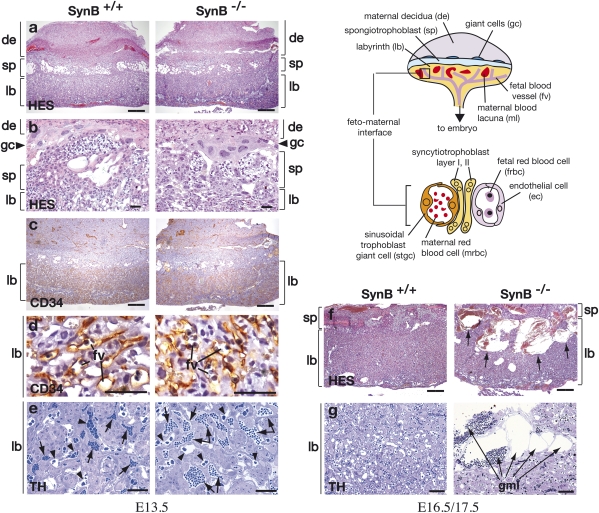Fig. 3.
Placental anomalies in the labyrinth of syncytin-B null embryos. (Scheme) Schematic representation of the mouse placenta showing the labyrinth (lb), spongiotrophoblast (sp), and giant cells (gc) adjacent to the maternal decidua (de). In the lb (enlarged lower), maternal blood lacunae containing maternal red blood cells (mrbc) are separated from fetal blood vessels (fv) containing nucleated fetal red blood cells (frbc) by a barrier composed of mononuclear STGCs (stgc) and two syncytiotrophoblast layers (ST-I and ST-II), with the latter apposed to the fetal endothelial cells (ec). Light microscopy analysis of WT and mutant placental tissues from E13.5 (A–E), E16.5 (F), and E17.5 (G) embryos. (A and B) HES staining of 7-μm placental sections with the lb, sp, and de delineated, and with the gc shown in the enlarged view in B. The four indicated layers are organized normally in the placenta of SynB−/− mice. (C and D) CD34 histochemical analysis of placental sections showing normal invasion of CD34-positive fbv through the lb; the enlarged view in D shows that the fv are regularly distributed and not squeezed. (E) Thionin (TH) staining of semithin 1-μm placenta Epon sections; in mutant placenta, the maternal blood lacunae (arrows) containing anucleated red blood cells are numerous and significantly enlarged, with evidence of blood stasis. The area of fv (arrowheads) is not significantly modified. (F) HES staining of 7-μm placental sections; the lb of SynB−/− placenta contains dramatically enlarged maternal blood lacunae (arrows) extending from the sp throughout the entire labyrinthine zona. (G) TH staining of semithin 1-μm placenta Epon sections showing, in mutant placenta, several juxtaposed dilated maternal lacunae (arrows) separated by thin walls about to rupture. (Scale bars: A, C, and F, 400 μm; B, D, E, and G, 50 μm.)

